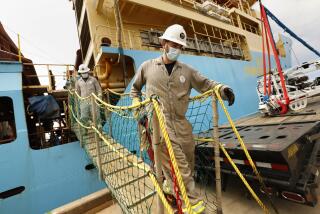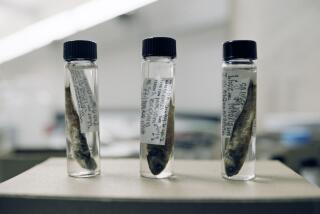Shrimp Industry Finds Life in Gulf Coast ‘Dead Zone’
INTRACOASTAL CITY, La. — For six days, the crewmen of the Thuan Hai shrimp boat floated in the Gulf of Mexico, eating instant noodles in silence, hauling in empty nets and coming to hate the dark water below. Resolved to failure, they headed back to port in Louisiana, sailing through a section of the gulf called the “dead zone,” water that is typically too polluted and devoid of oxygen to support aquatic life.
Suddenly, they began catching 5-inch shrimp -- 5,000 pounds worth, enough for a relatively successful trip.
The boat pulled up to a dock in this scrubby town, hidden in the briny bayou. As a conveyer belt brought the catch to shore, deckhand Su Vo took a long drag from a stubby cigarette. Yes, he said, he knows he is lifting a page of blasphemy from the fisherman’s bible. But he knows what saved his trip: bad weather.
Researchers sailing the gulf late last month discovered that the dead zone is suddenly, and drastically, smaller than it has been in nearly a decade. Salvation, the scientists say, came in a curious form: two powerful storms that raked Texas and Louisiana this summer, stirring the waters of the gulf and reintroducing oxygen -- and life -- into polluted waters.
“Before the storms, the shrimp died and sank to the bottom. And the fish, they floated on the surface like they had balloons in their stomachs,” Vo, 63, said this month in the galley of the Thuan Hai. “Not anymore.”
The dead zone has formed each year for at least two decades, and most scientists attribute it largely to fertilizer and other runoff pollution that originate in the Midwest. The pollutants cascade down the Mississippi River and other nearby waterways and spill into the gulf. There, they form large algae blooms that sap the water of oxygen. Some larger species can swim to healthier water, but the majority of aquatic life, including shrimp, becomes trapped and dies.
For the last two years, the zone has reached its largest recorded size: more than 8,000 square miles, almost the size of New Jersey.
The researchers, by sampling water late last month at 90 offshore stations stretching from the Mississippi River delta to the Texas-Louisiana border, determined that the zone is about 3,320 square miles, or less than half what it has been for much of the last two years, said Dr. Nancy Rabalais, a professor at the Louisiana Universities Marine Consortium and a leader of the research expedition.
Though the scientists expect the dead zone to reassemble and strengthen in coming weeks and months, a bout of bad weather has at least brought a glimmer of hope to a beleaguered industry.
Federal government forecasters said this month that they expect a busy Atlantic storm season; as many as nine hurricanes and 15 tropical storms could arrive off the southeast United States.
Like Vo, many commercial fishermen -- while they would never welcome destruction to the coast -- say quietly that a busy storm season could continue to break up the dead zone and build new, healthy fisheries.
“It sounds like a miracle,” said Eddie Gordon, president of the Southern Shrimping Alliance, when told about the reduction in the size of the dead zone. “And the shrimp industry needs some miracles right now.”
Indeed, along the Gulf Coast it is not a time of celebration -- far from it. That commercial fishermen have been reduced to hoping for bad weather is a reflection of the sorry state of the region’s once-mighty shrimp industry. For several years, shrimpers have fought soaring fuel and insurance prices, labor shortages and plummeting shrimp prices. Then about two years ago, a rising tide of imported, farm-raised shrimp turned into a flood.
More than 85% of the 1.4-billion pounds of shrimp eaten in the United States each year is imported from Latin America and Asia, a chief factor in driving down prices. Shrimpers have accused exporters of illegally dumping farm-raised shrimp into the United States at below-market prices, an allegation those countries have denied.
The public grandstanding over imports underscores the terrible turn in the economy of the Gulf Coast commercial shrimping industry, which employs more than 70,000 fishermen.
Banks have foreclosed on scores of shrimp boats. Many shrimpers who can afford the monthly payments on their boats are letting them sit idle at piers and docks. The reason: Fishermen in some areas sell their shrimp for less than 80 cents a pound -- less than it costs for a gallon of gasoline.
“You don’t make money with those kinds of numbers,” said Joseph Doan, an owner of Intracoastal Seafood Inc.
Doan, 44, a middleman of sorts in commercial fishing, bought about a million pounds of shrimp from fishermen last year. His business earned between 10 and 15 cents per pound by selling the shrimp to processing plants. The business is based at the Louisiana dock where the Thuan Hai, one of 18,000 shrimp boats that have historically fished the gulf, was docked.
Doan often pays fishermen ahead of time for the shrimp they hope to catch -- an unusual arrangement that can cost him dearly. But, he points out, tough times call for tough business decisions.
“If they don’t make it,” he said, “I don’t make it. And you have to put your conscience to work too. Life on the sea, it’s hard. We all work hard. We are in this together.”
With so many perceived hurdles before them, some shrimpers question the contention that a shrinking dead zone will give their industry a significant boost.
That’s because the situation has become so dire, they say, that to a degree it doesn’t matter how many shrimp they catch. They say they still can’t make a profit -- a conundrum that prompted Congress to provide $35 million in disaster-relief funding this year, a move that some saw as the beginning of a long-term federal subsidy for the industry.
“No matter how much we catch, we aren’t making ends meet,” said Dean Falgout, 46, a Houma, La., resident and a commercial fisherman since he was 17. “Last year, I caught more shrimp than the year before and I made less money. Everything is overpriced right now except the shrimp.”
Calvin Nguyen, the executive director of the Vietnamese-American Commercial Fishermen’s Union and a New Orleans resident whose family has been in the shrimping business since 1978, said the time has come to focus on laws, regulations and competition, not the environment.
“Most of these things are man-made problems,” he said. “We’d rather not depend on Mother Nature.”
The majority of people connected to the industry, however, as well as scientists who are struggling to address pollution problems that contribute to the dead zone, say the reduction in its size is at least a step in the right direction.
A coalition of government agencies and states that border the Mississippi has launched an initiative to reduce the pollutants and the size of the dead zone. Federal legislation approved last year offers farmers incentives to reduce fertilizer use.
But much of the burden of funding measures that could make a significant dent will fall to state governments, said William Mitsch, a professor of natural resources and environmental science at Ohio State University and one of the scientists trying to tackle the dead zone. Most state governments are strained and cannot afford to fund the campaign adequately, he said.
So Mother Nature, for now, might be the industry’s best ally.
“If the gulf stays stirred up, that’s the best they can hope for -- at least until we figure out how to solve the problem up here,” Mitsch said. “And that’s going to take a while. The whole thing is moving at a snail’s pace.”
At the Intracoastal City dock, several workers finished unloading the catch from the Thuan Hai. Falling shrimp antennae formed a virtual curtain on the end of the conveyer belt, attracting the attention of a small dog and a giant cluster of flies.
Ty Ha, 63, the captain of the Thuan Hai, looked on, still wearing his stained blue work shirt and his white rubber boots. He smiled wearily at the short stack of boxes of ice and shrimp that dock workers had put together from his catch -- three weeks’ work.
“I think we can do better in the near future. The storms have helped,” he said. “But it all depends on nature. Who knows how long it can last?”
More to Read
Sign up for Essential California
The most important California stories and recommendations in your inbox every morning.
You may occasionally receive promotional content from the Los Angeles Times.










